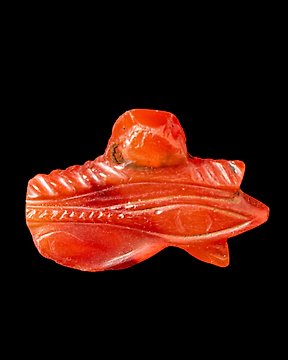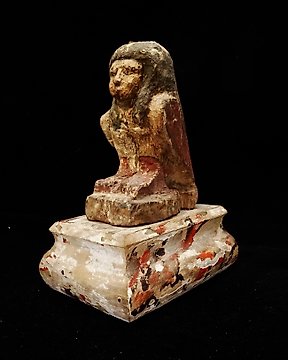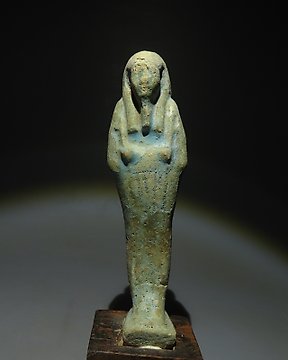古埃及 Faience 沙卜蒂。 11.1 厘米高。晚期,公元前 664 - 332 年
编号 84339031

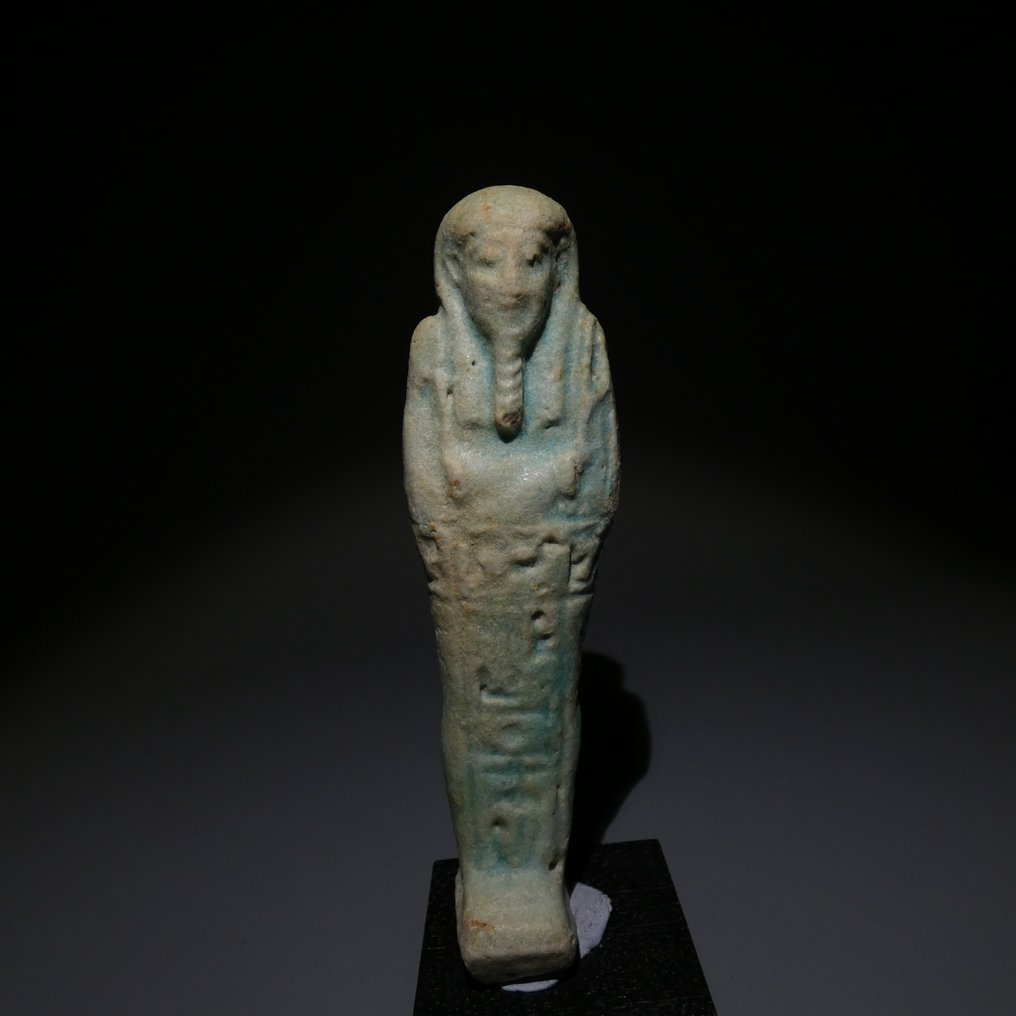
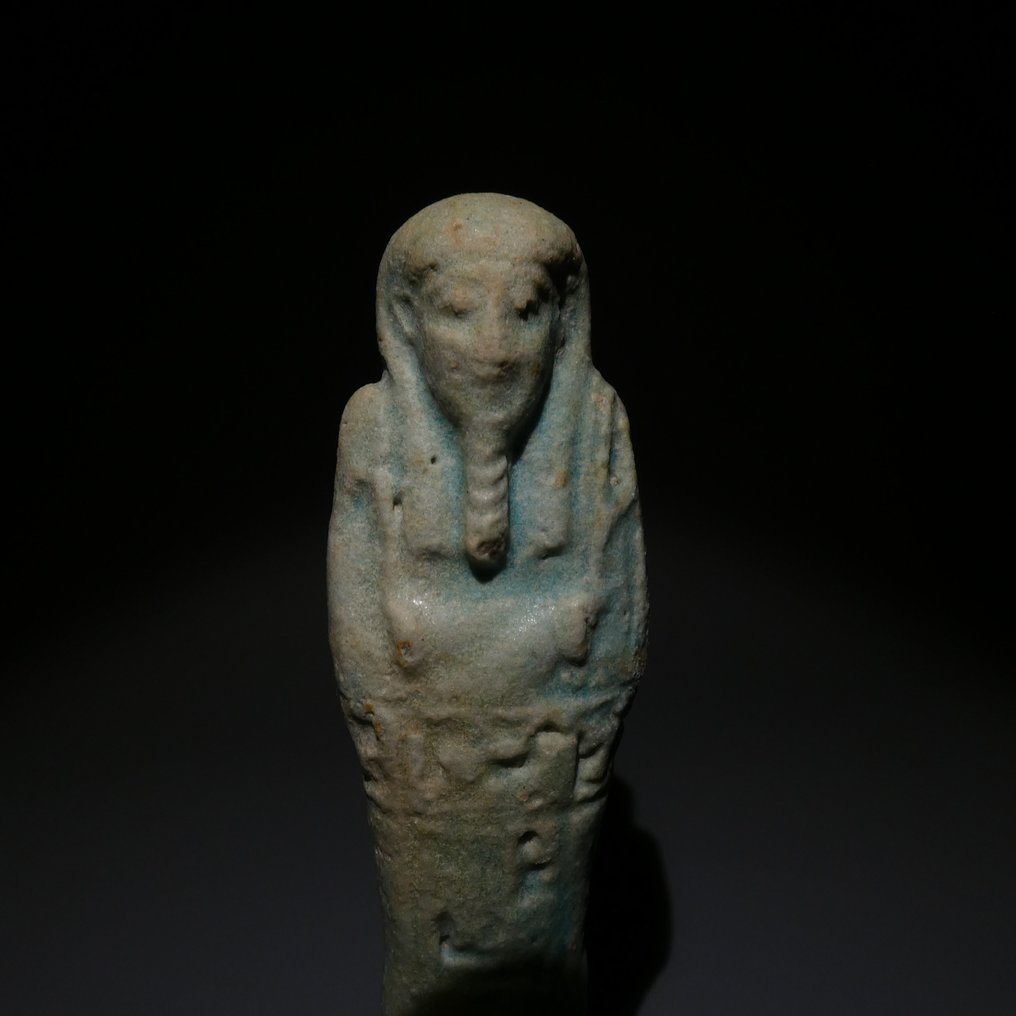
Shabti
Ancient Egypt, Late Period, 664 - 332 BC
MATERIAL: Faience
SIZE: Height 11,1 cm
PROVENANCE: Private collection, London, acquired in 1970s.
CONDITION: Good, see photos.
The faience shabti has and fine modelled details of the face, the plaited beard, striated tripartite wig, hands and hoes. The figure has a pedestal and a back pillar.
The Egyptian Afterlife was understood as a mirror of the real world, where both good and evil had their place. Those who were unfair or evil were punished for eternity, while the just enjoyed a comfortable existence travelling with the solar god. Even then, the deceased who were so blessed were still obliged to fulfil human responsibilities and needs, in the same way they had to in life. Their need to have food and drink in the Afterlife was a constant worry for them. If they were obliged to work in the Fields of Aaru, in the Realm of the Dead, and as members of a society which was a hierarchy governed by the gods, everyone – men and women, lords and servants, kings and queens – had to be willing to cultivate, sow and harvest the crops.
In the world of the living these basic tasks of production were carried out by the lower classes in society. To avoid this fate, Egyptians looked for a magic solution: they created one or more figures of themselves to be able to hand over to the emissaries of the reigning god, Osiris, when these called on the deceased to fulfil his obligations. These statuettes, placed amongst the grave goods in the tomb, were images which represented both the master and the servant.
They are known by the name of ushabtis, the term coming from sabty or shabty, derived from Sawab, the meaning of which corresponds to the Greek word “persea”, a sacred tree from whose wood the ancient Egyptians began to produce these funerary effigies. It was towards the Third Intermediate Period, in Dynasty XXI, around 1080 BC when they began to use the term wsbty, that is, “ushebty”. From then on the name “ushabti” derived from the verb wsb meaning “to answer” was used to name “he who answers”.
The use of ushabtis was incorporated into the burials in Ancient Egypt from the First Intermediate Period on. Their use grew during the Middle Kingdom, the time when the Egyptians began to write a spell in the Coffin Texts, number 472, so that the ushabtis would answer to the call: “The justified N. says ‘Oh ushabti, allotted to N, if N is summoned to do any work, or if a disagreeable task was asked of N as for any man for his duty, you are to say ‘I am here’. If N is called to watch over those who work there, ploughing the new fields to break the earth, or to ferry sand in a boat from east to west, you will say ‘I am here’. The justified N.”
This spell or utterance went on to be inscribed on ushabtis, and so in most cases, it appears there engraved. From the New Kingdom on, a great number of innovations were introduced. Examples with texts started to proliferate. Some of these were somewhat longer texts from Chapter VI in the Book of the Dead. Even so, in many cases the text simply indicates the name of the deceased, or a basic utterance, with the name of a family member or the posts that he held.
Ushabtis at first were made above all from wax, later from wood, and then towards the end of the Middle Kingdom they appeared in stone. From the New Kingdom on, the material par excellence was faience. We know they were produced in multiples thanks to moulds which have been preserved, and where in some cases, the engraved texts were unfinished, as the name of the owner was missing. The most popular form was that of the mummy until the introduction, towards the end of Dynasty XVIII, of figures decorated with everyday clothing. Many carried implements to work in the fields, such as a basket, a hoe or a pick, as a reference to the task to be carried out which was awaiting them in the Afterlife, as the symbolic representation of their master. The iconography, texts, materials, colours and their placing in the tomb could suggest other symbolic meanings.
Sometimes they were placed in wooden boxes, which could be either simple ones or with sophisticated decoration. In the New Kingdom they came to be placed in miniature sarcophagi.
While at first they were considered to be replicas of the deceased, in the New Kingdom and later, the ushabtis came to be seen as servants or a manner of slave, and for this reason they were produced en masse. There were both women and men, including specialists in different activities. Sometimes they were under the supervision of overseers, and these were distinguished by the use of a kilt. This is the case for the pharaoh Tutankhamun: he had three hundred and sixty five ushabtis at his command, one for each day of the year; thirty six overseers, one for each team of ten workers; and twelve master overseers, one for each month of the year. This came to a total of four hundred and thirteen servants in the Otherworld. The fear of having to carry out these tasks demanded of the dead by Osiris meant that in some burials there were even ushabtis who were there to act as substitutes or stand-ins, if necessary, for the main ones.
It is logical to think that no pharaoh would have wanted to carry out this type of task personally, and so at the necessary moment the utterance written on the body of the ushabti was read out so that this object acquired life to answer to the call, substituting for the pharaoh in the work.
Notes:
The seller guarantees that he acquired this piece according to all national and international laws related to the ownership of cultural property. Provenance statement seen by Catawiki.
According to Spanish legislation, items sent outside the European Union are subject to export taxes and will be added to the invoice, at the buyer's expense. These export fees are fixed on the final auction price and the tax rate is not applied directly on the total value of the item to be exported, but rather the different percentages by sections are applied to it:
- Up to 6,000 euros: 5%.
- From 6.001 to 60.000 euros: 10%.
This export permit application process can take between 1 months maximum.
Shabti
Ancient Egypt, Late Period, 664 - 332 BC
MATERIAL: Faience
SIZE: Height 11,1 cm
PROVENANCE: Private collection, London, acquired in 1970s.
CONDITION: Good, see photos.
The faience shabti has and fine modelled details of the face, the plaited beard, striated tripartite wig, hands and hoes. The figure has a pedestal and a back pillar.
The Egyptian Afterlife was understood as a mirror of the real world, where both good and evil had their place. Those who were unfair or evil were punished for eternity, while the just enjoyed a comfortable existence travelling with the solar god. Even then, the deceased who were so blessed were still obliged to fulfil human responsibilities and needs, in the same way they had to in life. Their need to have food and drink in the Afterlife was a constant worry for them. If they were obliged to work in the Fields of Aaru, in the Realm of the Dead, and as members of a society which was a hierarchy governed by the gods, everyone – men and women, lords and servants, kings and queens – had to be willing to cultivate, sow and harvest the crops.
In the world of the living these basic tasks of production were carried out by the lower classes in society. To avoid this fate, Egyptians looked for a magic solution: they created one or more figures of themselves to be able to hand over to the emissaries of the reigning god, Osiris, when these called on the deceased to fulfil his obligations. These statuettes, placed amongst the grave goods in the tomb, were images which represented both the master and the servant.
They are known by the name of ushabtis, the term coming from sabty or shabty, derived from Sawab, the meaning of which corresponds to the Greek word “persea”, a sacred tree from whose wood the ancient Egyptians began to produce these funerary effigies. It was towards the Third Intermediate Period, in Dynasty XXI, around 1080 BC when they began to use the term wsbty, that is, “ushebty”. From then on the name “ushabti” derived from the verb wsb meaning “to answer” was used to name “he who answers”.
The use of ushabtis was incorporated into the burials in Ancient Egypt from the First Intermediate Period on. Their use grew during the Middle Kingdom, the time when the Egyptians began to write a spell in the Coffin Texts, number 472, so that the ushabtis would answer to the call: “The justified N. says ‘Oh ushabti, allotted to N, if N is summoned to do any work, or if a disagreeable task was asked of N as for any man for his duty, you are to say ‘I am here’. If N is called to watch over those who work there, ploughing the new fields to break the earth, or to ferry sand in a boat from east to west, you will say ‘I am here’. The justified N.”
This spell or utterance went on to be inscribed on ushabtis, and so in most cases, it appears there engraved. From the New Kingdom on, a great number of innovations were introduced. Examples with texts started to proliferate. Some of these were somewhat longer texts from Chapter VI in the Book of the Dead. Even so, in many cases the text simply indicates the name of the deceased, or a basic utterance, with the name of a family member or the posts that he held.
Ushabtis at first were made above all from wax, later from wood, and then towards the end of the Middle Kingdom they appeared in stone. From the New Kingdom on, the material par excellence was faience. We know they were produced in multiples thanks to moulds which have been preserved, and where in some cases, the engraved texts were unfinished, as the name of the owner was missing. The most popular form was that of the mummy until the introduction, towards the end of Dynasty XVIII, of figures decorated with everyday clothing. Many carried implements to work in the fields, such as a basket, a hoe or a pick, as a reference to the task to be carried out which was awaiting them in the Afterlife, as the symbolic representation of their master. The iconography, texts, materials, colours and their placing in the tomb could suggest other symbolic meanings.
Sometimes they were placed in wooden boxes, which could be either simple ones or with sophisticated decoration. In the New Kingdom they came to be placed in miniature sarcophagi.
While at first they were considered to be replicas of the deceased, in the New Kingdom and later, the ushabtis came to be seen as servants or a manner of slave, and for this reason they were produced en masse. There were both women and men, including specialists in different activities. Sometimes they were under the supervision of overseers, and these were distinguished by the use of a kilt. This is the case for the pharaoh Tutankhamun: he had three hundred and sixty five ushabtis at his command, one for each day of the year; thirty six overseers, one for each team of ten workers; and twelve master overseers, one for each month of the year. This came to a total of four hundred and thirteen servants in the Otherworld. The fear of having to carry out these tasks demanded of the dead by Osiris meant that in some burials there were even ushabtis who were there to act as substitutes or stand-ins, if necessary, for the main ones.
It is logical to think that no pharaoh would have wanted to carry out this type of task personally, and so at the necessary moment the utterance written on the body of the ushabti was read out so that this object acquired life to answer to the call, substituting for the pharaoh in the work.
Notes:
The seller guarantees that he acquired this piece according to all national and international laws related to the ownership of cultural property. Provenance statement seen by Catawiki.
According to Spanish legislation, items sent outside the European Union are subject to export taxes and will be added to the invoice, at the buyer's expense. These export fees are fixed on the final auction price and the tax rate is not applied directly on the total value of the item to be exported, but rather the different percentages by sections are applied to it:
- Up to 6,000 euros: 5%.
- From 6.001 to 60.000 euros: 10%.
This export permit application process can take between 1 months maximum.
- 117
- 7
- 0
Parfait, très bonne communication. Muchas gracias.
查看翻译Bestens, danke!
查看翻译todo bien 👍
查看翻译Llego muy bien y es muy bonita. Gracias
查看翻译Vendeur très professionnel & réactif. Colis parfaitement protégé. Merci encore
查看翻译todo bien 👍
查看翻译Oggetto valido anche se il venditore doveva inviare un supporto per esporre : tanto più che trattasi di venditore professionale. La certificazione inviata è ambigua sulle dichiarazioni rillasciate
查看翻译Todas sus piezas han sido cuidadosamente seleccionadas , en garantía del comprador.
查看翻译Muy linda, dura y con buen peso. Envío super rápido.
查看翻译todo bien 👍
查看翻译as described, all godd, thank you!
查看翻译Very nice as discribed
查看翻译Vakkundige verpakking tijdens transport.Zou echter een officiële bevestiging willen van de echtheid
查看翻译Exceptionnel !!! Envoi rapide et soigné. Un dernier mot : MAGNIFIQUE !!!
查看翻译Todo correcto.
查看翻译Oggetto molto bello e come da descrizione. Nel pacco erano allegati anche ricevuta d'acquisto e dichiarazione di autenticità del venditore. Tutto bene!
查看翻译I'm very happy !!! Beautiful. Rapide et efficace!! LLAP
查看翻译Vlotte verzending met DHL. Professionele verpakking en certificaat. Met dank.
查看翻译Item arrived quickly and carefully packaged, I am very pleased with it!
查看翻译Sehr rasche Transaktion und schönes Stück!!
查看翻译El pequeño busto es hermoso. Bien empaquetado. Entrega rápida. Estoy satisfecho 👍👍👍
查看翻译Muy buen vendedor , productos muy especiales atento en ls información del producto como el envío . Gracias
查看翻译Très belle statuette. Livraison rapide. Je suis très satisfait et recommande ce vendeur. ⭐️⭐️⭐️⭐️
查看翻译Merci bel objet !
查看翻译- 117
- 7
- 0
免责声明
卖家保证并能证明该物品是合法获取的。 Catawiki 通知卖家,他们必须提供其居住国法律法规所要求的文件。 卖家保证并有权出售/出口此物品。 卖家将向买家提供有关该物品的所有已知的原产地信息。 卖家确保已经/将安排任何必要的许可。 卖家将立即通知买家有关获得此类许可可能产生的任何延误。
卖家保证并能证明该物品是合法获取的。 Catawiki 通知卖家,他们必须提供其居住国法律法规所要求的文件。 卖家保证并有权出售/出口此物品。 卖家将向买家提供有关该物品的所有已知的原产地信息。 卖家确保已经/将安排任何必要的许可。 卖家将立即通知买家有关获得此类许可可能产生的任何延误。





